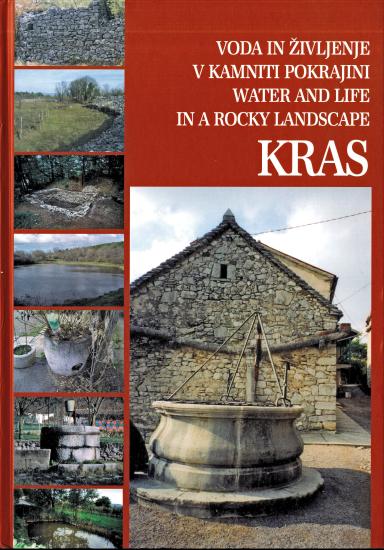
Kras: Water and Life in a Rocky Landscape
Edited by:
Andrej Mihevc
Year:
2005
Book is a result of the Slovene part of the research of the karst plateau Kras. Work was done in the frame of European project AQUADAPT. In the book experts from different fields presented historical view on relations between the resources, mainly water and the society and also the sociologic and cultural conditions defining present use of water on Slovene karst.
Characteristics of the Kras plateau landscape are vast rocky dry bare land, which is today overgrown by forests, small scattered settlements and scarce agricultural surfaces. The lack of soil that could cover the rocks and water that flows deep below the surface are the main characteristics of Kras. In the past when most people live out of farming these were also the main limiting factor for life and settlement. In last decades les and less people lives out of farming only and the fore the lack of soil is not important factor any more and lack of water was saved by regional pipelines. Kras plateau is because of good transport conditions and pleasant climate became interesting for some different activities and settlement, but fast growing settlements and badly planned economic development can in very short time destroy numerous qualities that are preserved in the landscape and endanger underground water sources.
Research had a multidisciplinary approach; participants were geographers, geologists, biologists, archaeologists, historians, ethnologists and others. They were focused on the adaptations of people to the karst landscape, how they changed it, how they managed the water supply and how karst marked the people and society. Research took of wide spectrum of phenomena that show the relation between man and environment. The geologic structures control the direction and the manner of water discharge trough Kras, the lithology defines degree of rockiness, formation of soil and fine relief of the surface. They study the impact of the land use on surface morphology that is expressed with clearing of the rock from the surface, building dry walls and soil erosion. On the Kras and on its edge first settlements were formed in prehistory, and traces of settlements are all related and show the importance of the natural conditions. Biologist studied special fauna of the natural and artificial ponds and cisterns and the remnants of the former natural vegetation. Change in vegetation and fast overgrowing bare lands with trees with help of remote sensing and analyse of satellite images.
Daily care for water deeply reflects in culture and folk culture so special chapter is dedicated to ethnology, which show the relation to water which is on the Kras plateau one of rare goods. The history of water supply and specially the building of water supply systems are also described. Besides social study was made about present water supply and modern relations of users to water, which is provided by public aqueducts.
Research made better knowledge on the relation between society and special karst environment on Kras plateau. It can help to better knowledge about the county since there are special requirements and special value that is coming out of special natural and cultural values.
-
Edited by
Other authors
editorial board
-
Publishing House:
Založba ZRC
-
Publisher
-
ISBN
961-6568-07-8
-
Year
2005
Language(s)
-
Specifications
hardback 21 × 29,5 cm 564 pages
-
E-publications
-
Permalink